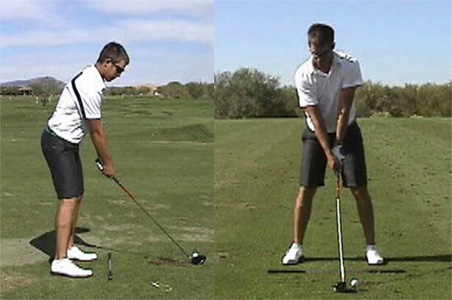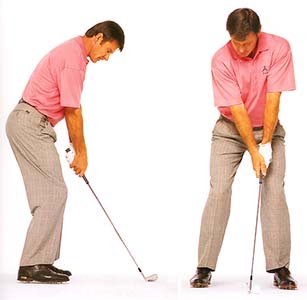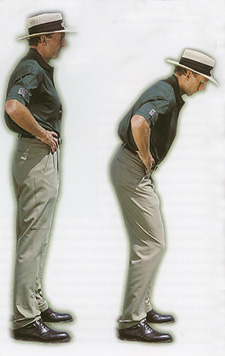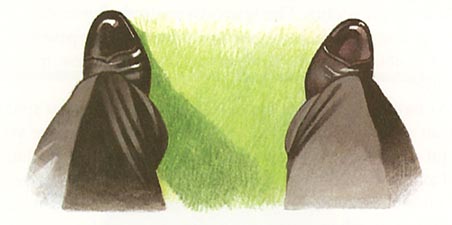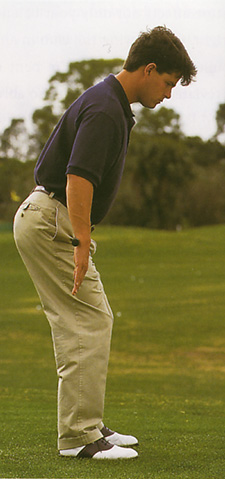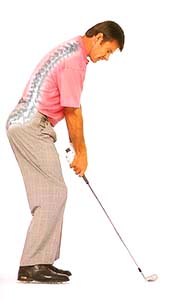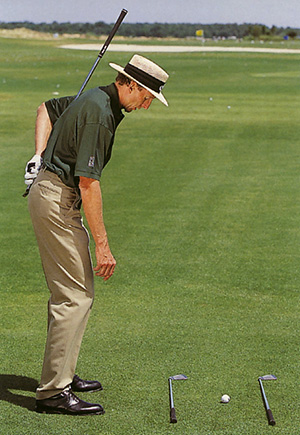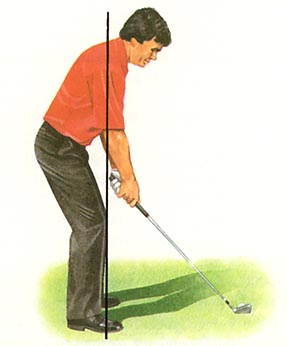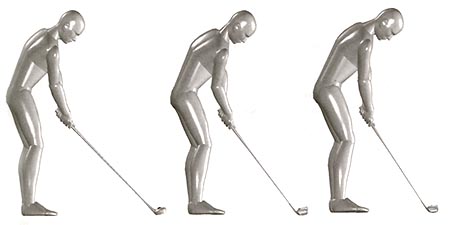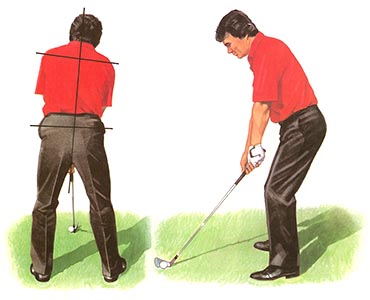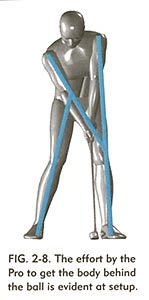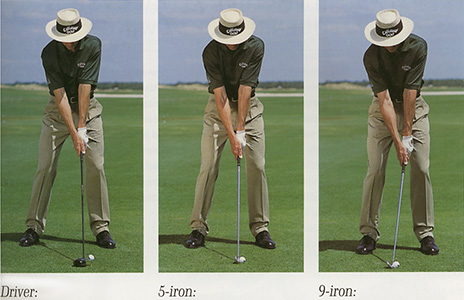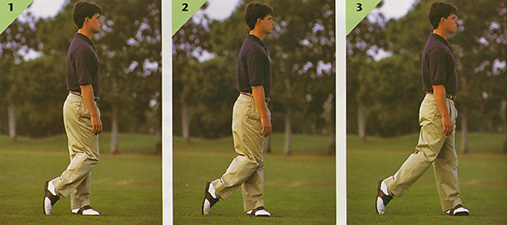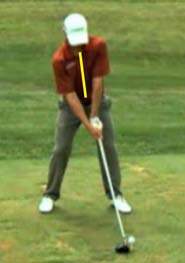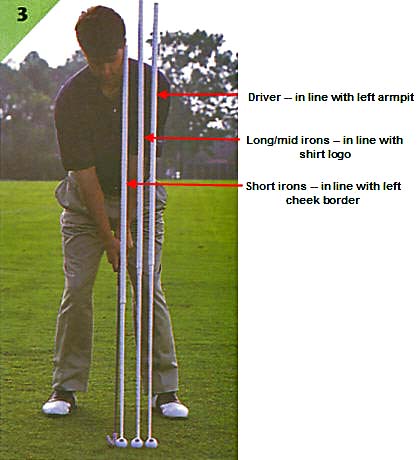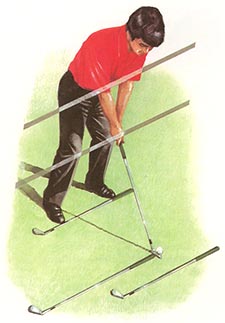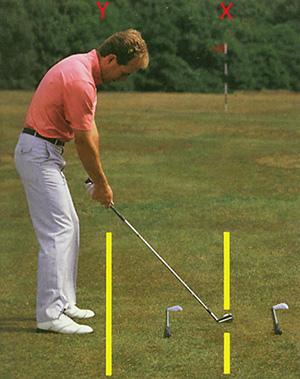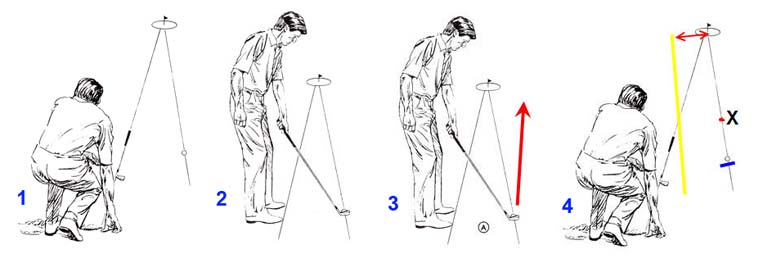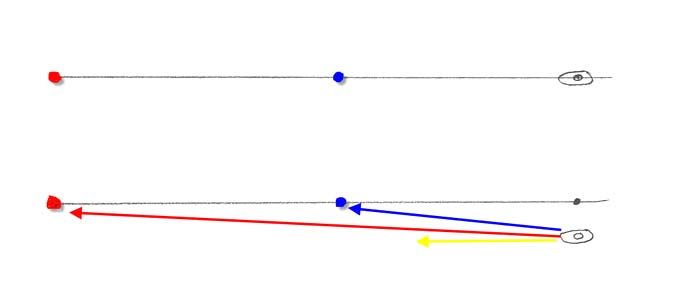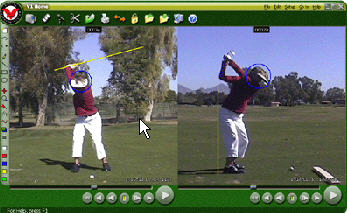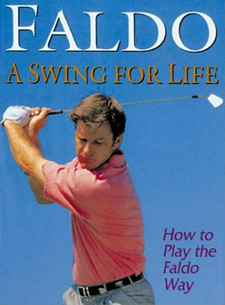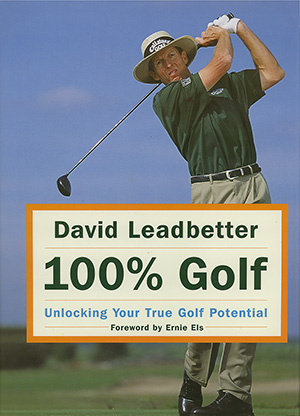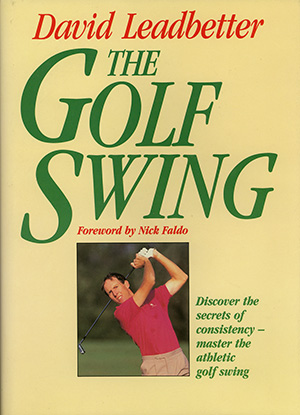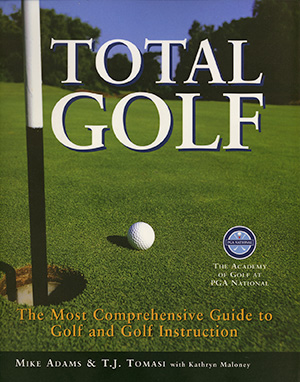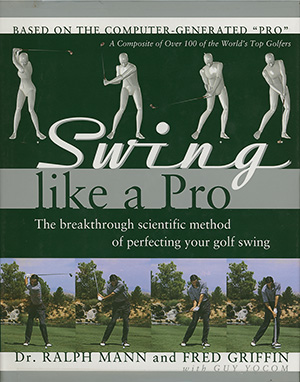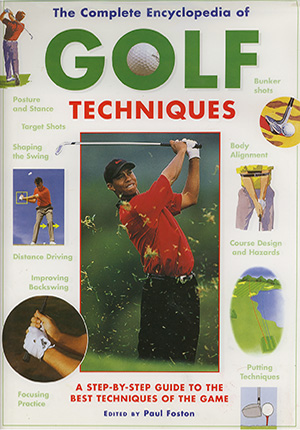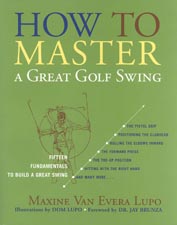Address Setup: Stance, Posture and Alignment
Click on any of the hyperlinks to rapidly navigate to another section of the review: Homepage (index); overview; grip; backswing; downswing; impact; followthrough-to-finish
Introduction:
One characteristic feature of a full golf swing is the fact that a golfer swings the club across the front of the body, while the body is aligned parallel to the ball-target line. That fact makes it difficult to aim accurately when standing sideways relative to the target at address. Another complicating issue is the fact that the clubhead moves on an inclined clubhead path that is tilted approximately 45 degrees from the horizontal, and the body has to swivel around (while the arms are swinging across the front of the body) in such a manner that an optimal clubhead swingpath can be consistently realised. Because the body's address posture and subsequent movement is subservient to a need to create an optimal clubhead swingpath, the body has to adopt a stance and posture at address, that will allow an optimal clubhead swingpath to occur naturally, and consistently, from swing-to-swing.
When watching a PGA tournament on TV, I find myself always admiring the athletic posture and perfect body alignment of PGA tour golfers as they get into their address position. PGA tour golfers always appear to have the correct body angles at setup and their 'lively' posture at address gives them an enviable aura of skilled athleticism. They appear to be in a state of perfect readiness to be able to swing the club at high velocity while maintaining perfect coordination and perfect balance throughout the swing. In this chapter of my complete review of the full golf swing, I will examine their approach to the address setup, and I will primarily be dealing with the body's position at address, with a major focus on the foot stance, body posture, and body alignment.
Address setup:
Consider the appearance of a PGA tour golfer at address.
Aaron Baddeley - from reference number [1]
One can sense the skilled 'athleticism' of Aaron Baddeley's setup posture. He seems perfectly poised to start the backswing. He appears to be in perfect balance and also perfectly aligned relative to the ball-target line. There appears to be a sense of ready 'liveliness' in his stance that will allow his body to move fluidly during the swing.
The same perfect posture can be seen in Nick Faldo's address position - when using an iron.
Nick Faldo at address- from reference number [2]
There are so many features of Nick Faldo's address position that are perfect -- foot stance width, degree of bend in the knees (minimally more flexed than Aaron Baddeley's), degree of forward bend at the level of the hip joints, straight lower back, slightly rounded upper back, head in line with the spine, arms hanging naturally down from the shoulders, hands close to the body and not outstretched, hands slightly forward of the ball in the face-on view, head behind the ball in the face-on view, slight tilt of the spine to the right causing the right shoulder to be lower than the left shoulder, nose tilted to the right as the head turns slightly to the right in sympathetic alignment with the spine tilt, body weight seemingly centralised over the mid-feet (down-the-line view) and between the feet (face-on view).
In the following section of the review, I will provide detailed advice on how a golfer can best mimic Nick Faldo's perfect address posture.
Getting started - adopting the correct address position:
The easiest method of learning how to adopt a perfect address position is to start from the groundup. David Leadbetter recommends first starting with the body erect and the feet approximately a shoulder's width apart. Then, one bends the knees slightly as if one is getting ready to sit down on a bar stool - as demonstrated in the following photo.
Address posture - from reference number [3]
The correct amount of knee flex can be determined by looking down at one's knees, and noting that a vertical line passing just in front of the kneecap will pass through the balls of the foot, or through the junction of the forefoot and midfoot - as seen in the following diagram. If the vertical line passes in front of the toes, then the knees are too flexed. If the vertical line passes through the rear end of the midfoot, then the knees are insufficiently flexed.
Flexed knee position - from reference number [4]
As one bends the knees, one should simultaneously push the hips back so that one creates the appropriate bend at hip level. It is important to bend at the hips and not the waist. To accomplish that feat, one should have a distinct feeling that one is sticking out one's rear-end (as demonstrated by David Leadbetter in his address posture photo). Note that if one bends at the hips, and not the waist, that the lower back becomes straight, and not rounded and bent/stooped. When one adopts this straight lower back posture, one should feel like a competitive Olympic swimmer at the edge of a swimming pool, who is ready to dive head-first into the pool when the starter shoots his starting pistol. Another useful visual analogy is to imagine the athletic position of a American football quarterback who is waiting to receive the ball from a huddle, or a professional tennis player waiting to receive a serve. What particularly characterises these sport "readiness-postures" is a straight lower back, slight bend at the hips and knees, and a sense of 'lively' readiness in the legs. The flexed knees should be perceived to be like 'coiled springs', that can readily allow the torso and hips to swivel and turn with the utmost ease. The legs should not be too straight (too hyperextended at knee joint level) and the knees should also not be excessively bent.
If a golfer has difficulty getting the correct flex at the hips (rather than at the waist), then the following photo may be helpful.
Bending at the hips - from reference number [5]
Note that the golfer has placed a clubshaft against the front of his upper thighs, and he then bends forward at the hips while pressing the clubshaft firmly against the thighs. This will enable him to stick-out his rear end (butt/tush) and bend appropriately at the hips while keeping the lower back relatively straight (relatively straight = naturally/biomechanically straight where there is a small degree of retained lumbar lordosis of the lumbar spine).
Nick Faldo at address with superimposed image of the spine
Note that the lumbar spine is still slightly lordotic, and not abnormally hyperextended or kyphotic, at address.If a golfer has difficulty adopting a straight back position, David Leadbetter suggests positioning a clubshaft along the length of the lower back - as demonstrated in the following photograph.
Adopting a straight lower back - from reference number [3]
It is important to realise that a golfer needs to adopt a straight lower back posture without losing the slight roundness of the upper back. Trying to adopt a straight back all the way from the hips to the neck results in an overly rigid, and unnatural, straight back back posture.After a golfer has acquired the correct amount of knee flex, the correct bend at the level of the hip joints, and a straight lower back - then he should ensure that his head is is line with the spine by straightening the neck. Many beginner golfers have an overly flexed neck at address, because they are looking straight down at the ball. If the neck is overly flexed, then the chin will impede the rotational movement of the left shoulder in the backswing and the right shoulder in the downswing, and thereby disrupt the swing. A golfer should make a conscious effort to lift his chin slightly - and he may then acquire a distinct feeling that he is looking down over his upper cheek when looking down at the ball. However, a beginner golfer shouldn't over-compensate, and over-straighten the neck, and thereby lose the rounded appearance of the upper back in the address position. A good compromise head position is the position of David Leadbetter's head in the photo above, or a degree of forward neck bend that is slightly greater in degree than the amount demonstrated by David Leadbetter in that photographic image.
After a golfer has acquired the correct amount of knee flex, the correct bend at the level of the hip joints, a straight lower back and a straightened neck - then the golfer should ensure that the hands hang vertically down from the shoulders in a relaxed manner when the clubface is placed behind the ball. The golfer should avoid any feeling that he is excessively stretching-out the arms towards the ball, and the correct arm posture is demonstrated in the following artist-drawn diagram.
Shoulder line - from reference number [4]
Note that a vertical line passing down from the middle of the right shoulder will pass just behind the middle of the right upper arm, and pass just in front of the knee cap to hit the ground through the forefoot. If a golfer adopts this postural recommendation, then he will have acquired the correct amount of bend at the hips and the correct arm alignment.
If a golfer bends too much at the level of the hips thereby increasing the degree of forward spinal bend inclination, then the vertical line drawn from the middle of the shoulder will pass in front of the forefoot. He will then note that his weight is not distributed evenly between the heels and forefeet, and that there is too much weight over the forefeet. That degree of forward weight distribution can cause a golfer to become unbalanced during the downswing and predispose the golfer to falling forward towards the ball during the downswing.
If a golfer bends too little at the hips, then the vertical line will pass behind the kneecaps to hit the ground in the region of the rear midfoot. The golfer will then be standing too erect, and there will be a sense that there is more weight on the heels relative to the balls of one's feet. Optimally, a golfer's weight should be evenly distributed between the heels of the feet and the balls of the feet, and he should be able to lift up the back of his heels slightly (or lift up his toes) without becoming unbalanced if his body weight is evenly distributed over the feet.
It is interesting to note that there should be very little difference in the degree of bend-at-the-hip and the degree of vertical arm positioning when hitting a driver compared to hitting a short iron.
Consider the following photo of the appropriate posture when hitting a driver, a long iron, and a short iron.
Distance from the ball - from reference number [6]
Note that there is slightly more bent-over posture with the short iron (image 3) and that a vertical line drawn down from the middle of the right shoulder passes just in front of the kneecap as it passes down to hit the ground in the region of the forefoot. Note that the arms hang vertically down from the shoulders when using an iron (hands are just inside the chin), and that they are only minimally stretched-out when using a driver (hands are directly under the chin, or just in front of the chin). Note that the hands are very close to the thighs at address, and approximately 4-6" from the thighs when using a short iron, and approximately 6-8" from the thighs when using a driver - and that there is only a ~2" difference between the two hand (driver and short iron) positions.Now consider Aaron Baddely's address posture from a face-on view (using the same address position photo).
Aaron Baddeley address position - from reference number [1]
There are two important features to note-: i) Aaron Baddeley's spine is tilted a few degrees to the right and his right shoulder is lower than the left shoulder, and his head is behind the ball; ii) Aaron Baddeley's left hip is minimally higher than the right hip.This rightward-tilted spine postion is best appreciated when viewing a golfer from behind, as seen in this artist-drawn diagram from Leadbetter's book.
Rightward-tilted spine at address - from reference number [4]
These two address postural features are very important, and this particular positional aspect of the address posture produces the "reverse K" position, and it is demonstrated graphically in the following diagram.
Reverse K address position - from reference number [6]
Note that in this model (arbitrarily called the ModelPro), that the ModelPro has angled his right knee slightly inwards. Not all professional tour golfers choose this right knee angulation option, and many professional golfers (like Aaron Baddeley and Nick Faldo) adopt a more symmetrical knee alignment at address. Most importantly, note that the spine is tilted to the right and that the right shoulder is lower than the left shoulder. This postural adjustment has two important effects. First of all, it causes the head to move slightly to the right and move behind the ball. Keeping the head behind the ball throughout the backswing and downswing is a critical component of a good golf swing. Secondly, during the backsing, rotating the torso around a rightwards tilted spine allows the weight to more easily flow to the right side without any jerky, superadded lateral shift-movements. Thirdly, notice that with the ball positioned forward near the left heel, and the hands just forward of center (just inside the left thigh), that the clubshaft is angled slightly forwards - this address position encourages a slightly upwards movement of the clubhead through the impact zone, which is an advantage when driving a ball off a tee.The recommended degree of rightward tilt of the spine depends on the club being used. A distinct rightwards tilt of the spine is recommended when using a driver, because a golfer wants the clubhead to be travelling slightly upwards at the time of ball impact. With a fairway wood and long irons, a golfer usually wants to sweep the ball off the turf with a zero/minimal divot. Therefore, the rightwards tilt should be minimal. With a short iron, the golfer often wants to hit down on the ball with a more descending blow, and excess rightwards tilt of the spine may be a disadvantage.
This next face-on view photo from David Leadbetter's book [3] will allow me to discuss four seperate address position issues - stance width, weight distribution, arm/hand position and ball position.
David Leadbetter address position - from reference number [3]
Stance width
First of all, note that David Leadbetter *flares both feet open. Many professional golfers adopt a 10-30 degree flaring-out of both feet, because it allows the pelvis to rotate more easily during the swing. Flaring the feet open allows the legs/knees to rotate more easily in response to rotatory movements of the torso. This is especially relevant with respect to the left foot during the mid-late downwsing, when the body weight is driven powerfully across to the left side by an initiating lower body shift-rotation movement. Flaring the left foot open allows the left knee to more easily rotate counterclockwise as it straightens in the later downswing.
(* outwards flaring of the feet at address is optional, and many professional golfers prefer to have their feet aligned more square relative to the ball-target line at address)
Regarding the driver, David Leadbetter recommends that the inner distance between the feet should be equal to the shoulder width.
Regarding mid-irons, David Leadbetter recommends that the outer distance between the feet should roughly be equal to shoulder width.
Regarding short irons, David Leadbetter recommends that the outer distance between the feet be less than shoulder width, but not less than pelvic width.
Some golfers, who lack flexibility, may personally find David Leadbetter's driver stance width recommendation to be too wide, because it prevents their pelvis from rotating fully during their downswing and followthrough. It is therefore perfectly acceptable for an inflexible golfer to adopt a stance width that is closer to the width of the pelvis for all clubs - so that the knees are more vertically-aligned with their respective hip joints at address.
Another optional method of finding the correct stance width, which takes body flexibility into account, comes from the book "Total Golf" [5].
Stance width variations - from reference number [5]
The "Total Golf" authors recommend adopting a stance width, and then rotating the body 90 degrees counterclockwise so that the chest and pelvis fully face the target at the finish position. The "correct" stance width is a stance width that allows the knees to become aligned together and that allows the pelvis to fully rotate 90 degrees so that it faces the target at the finish position - see image 2 in the above composite photo of three stance width positions. Stance width variation number 1 is too narrow and it allows the pelvis to over-rotate, while stance width variation number 3 is too wide, preventing a more complete pelvis rotation (although many professional golfers still prefer that option for their driver swings).I think that each individual golfer should experiment with these two stance width approaches to find the best balance between rock-solid stability and a natural/easy rotational pelvic motion during the downswing/followthrough. A stance width that favors stability over easy rotational motion of the pelvis may be preferable when using a driver, while the opposite bias may be preferable when using an iron.
Weight distribution at address
David Leadbetter recommends that the weight distribution between the two feet (right foot relative to left foot) should be 55:45 with a driver, 50:50 with a mid-iron and 45:55 with a short iron. Some golf instructors recommend that the weight be evenly distributed between the feet for all clubs.
Arm/hand position at address
Notice that David Leadbetter places his hands in the same position, just left of center and just right of the inner left thigh, for all clubs. Many professional tour golfers routinely place their hands in a similar position at address - somewhere between the center of their stance and the left inner thigh. Note that when the hands are in this position nearer the left inner thigh, that the left arm is more straight line-aligned with the clubshaft at address. The final choice of hand position at address is optional - and it is perfectly acceptable for a golfer to have the hands more centralised between the thighs at address so that the clubshaft is more perpendicular relative to the ball-target line, which will cause the left wrist to become more bent (more dorsiflexed) at address.
David Leadbetter address position - from reference number [3]
At address, the two upper arms arms should be slightly adducted. At address, the left elbow pit (left antecubital fossa) should face more inwards (away from the target), while the right elbow pit (right antecubital fossa) should face more outwards (towards the ball-target line). That means that the left humerus is more internally rotated at address - compared to the right humerus. Golfers who adopt a stronger left hand grip will usually have more internal rotation of their left humerus at address - compared to golfers who adopt a weak/neutral left hand grip (like David Leadbetter).
Jamie Sadlowski at address - capture image from a swing video
Jamie Sadlowski adopts a very strong (4+ knuckle) left hand grip at address - note that his left humerus is more internally rotated and that his left forearm is more pronated (compared to David Leadbetter). However, note that there is no change in his right arm and right elbow alignment, and that his right antecubital fossa faces more outwards (in the direction of the ball-target line) - as seen in the address position images of David Leadbetter.Ball position
David Leadbetter recommends placing the ball just inside the left heel for the driver (ball position A), about 2 inches back of that position for a 5-iron, and roughly in the middle of the stance for a short iron (ball position B). The total distance from ball position A to ball position B is only about 3" (about the width of two golf balls).
The "Total Golf" authors recommend a different ball position approach that relates the ball position to the chest. and not the feet.
Ball position recommendations - from reference number [5]
Basing the ball position on its relationship to the torso makes sense, because it eliminates the variable effect that varying degrees of foot flaring may have on correct ball placement (when it is solely based on stance width).An important golf instructional point about ball position in these two ball position photographs - note that the head is always behind the ball irrespective of which club is being used. When using a short iron, some golfers prefer to have their head more directly over the ball, and their sternum marginally ahead of the ball, so that they can hit down on the ball with a steeper clubhead attack angle.
Note that the clubshaft angle/direction at address varies with different length clubs (see David Leadbetter address position photo). With a driver, the clubshaft is tilted slightly forwards in the direction of the target, and this encourages a slightly upward swing path at the point of ball impact. With a mid/long iron, the clubshaft is tilted only marginally backwards, and this encourages a flattish (or slightly descending) swingpath in the region of the ball and a shallow divot. With a short iron, the clubshaft is tilted slightly more backwards, and this encourages a steeper descending clubhead swingpath and a steeper clubhead attack angle.
There are no fixed rules when it comes to ball position, other than the general principle that the ball position should generally be forward of the center of the stance. I know of no golf instructor who recommends placing the ball back of the center position (closer to the back foot) for standard (non-specialised) full golf shots. Many golf instructors recommend a "fixed" forward ball position (eg. 2-3" inside the left heel) for all iron shots, and they simply recommend moving the right foot to vary the stance width, and consequently the ball's relationship to the right foot-versus-left foot, for different clubs.
An individual golfer can also find the best ball position for his individual full golf swing with an iron by personal experimentation - swinging different clubs and seeing where the divot starts (which roughly indicates the lowest point of the clubhead arc). The low point of the clubhead arc is usually situated vertically under the left shoulder socket (in the absence of excessive secondary axis tilt) and the low point (nadir) of the clubhead arc is usually located at the deepest part of the post-impact divot (if the golfer generates a divot). The ball should be positioned just behind the back end of the divot. Using this approach, most golfers will probably find that their optimum ball position for most fairway clubs is located approximately 2-4" inside the left heel.
Body alignment
Body alignment refers to the positioning of the body relative to the ball-target line.
The body should optimally be aligned parallel to the ball-target line for all standard shots, and each sub-section of the body (feet, knees, thighs, hips, shoulders) should be perfectly parallel to the ball-target line - as demonstrated in the following artist-drawn diagram.
Body alignment - from reference number [4]
The most important part of the body that has to be parallel to the ball-target line are the shoulders. The direction the arms will swing across the front of the body during the downswing is very much influenced by the direction of the shoulder line, and the arms will tend to follow the shoulder line. If the shoulders are pointing to the right of the target, then it is very likely that the arms will swing from in-to-out across the front of the body during the downswing. If the shoulders are pointing to the left of the target, then it is very likely that the arms will swing from out-to-in across the front of the body during the downswing.
Aiming
Aiming refers to the method of aligning one's clubface relative to the ball so that the clubface faces the target, and then the body is subsequently aligned parallel to the ball-target line.An useful method of aiming is to first stand about 6-12 feet directly behind the ball and then look down-the-line at the target. This allows one to see the ball-target line in one's mind without any parallax distortion that occurs if one attempts to define the ball-target line from a side-viewing perspective. Many golf instructors then suggest that one choose an intermediate target along the ball-target line, that is situated approximately 3-6 feet in front of the ball eg. divot mark, clump of grass. Then one should move back to an address position opposite the ball, and place the clubshaft at an approximately 90 degree angle to the ball, so that the clubface faces the intermediate target. If the clubface faces the intermediate target, then the clubface must be perpendicular to the ball-target line.
David Leadbetter aiming the club - from reference number [3]
When aiming the clubface, one should look at the lower 2-3 groove lines of the clubface, and ensure that those groove lines are at right angles to the ball-target line. Don't look at the top of the clubface, because the top of the clubface is often angled in such a manner that it is not parallel to the clubface's groove lines. Also, note that the clubshaft may not be at right angles to the ball-target line when the clubface is at right angles to the ball-target line - because different clubs have varying degrees of offset (see photo). It is the clubface that needs to be at right angles to the ball-target line, and not the clubshaft. When one has the clubface's groove lines perpendicular to the ball-target line, then one should build one's stance around the clubface so that one is standing along a stance line that is perfectly parallel to the ball-target line. It is very important to understand that one's foot stance and body alignment (knees, thighs, pelvis, shoulders) should be positioned parallel to the ball-target line, and that one should not look at the target to verify correct foot/body alignment when standing alongside the ball in the address position. In fact, if one rotates one's head sideways to look at the target after getting into a parallel-to-the-ball-target line foot/body stance position, the target should "appear" to be situated a little to the right, because one is viewing the target from an eye-viewing position that is approximately 2-3 feet left of the ball-target line. A golfer should resist any inclination to change his foot stance/body alignment so that he "feels" that his body is directly facing the target, because this will cause him to aim right of the target by approximately 10-20 degrees. The correct reference point for aligning the stance/body when standing alongside the ball is the ball-target line (which was previously established when standing directly behind the ball), and not the target.
Foot, body and shoulder alignment - from reference number [7]
First of all, note that the feet are placed parallel to the ball-target line. Then one should ensure that the rest of the body (knees, thighs, hips, shoulders) is also parallel to the ball-target line. Note that the clubface is aimed at the flagpole, which is equivalent to aiming the clubface at point "X". Note that the feet and shoulders appear to be aiming at point "Y", which is far to the left of point "X", when viewed from a DTL perspective. This is a critical point, and when one turn one's head to look at one's left shoulder, it should appear to be be pointing well left of the target. In fact, one shouldn't easily see the left shoulder out of the corner of the left eye when one looks directly at the ball. If one clearly sees the left shoulder in one's left eye's peripheral visual field when looking at the ball, then it usually means that one is misaligned, and that the shoulders are in a closed position (and often pointing 10-20 degrees right of the target). Many beginner golfers face 10-20 degrees right of the target because they take aim at the target when standing sideways alongside the ball, and they subsequently, and mistakenly, align their shoulders to face the target. To avoid that problem, a golfer should always pre-visualize the ball-target line and also the stance/body line when standing 6-12 feet directly behind the ball, and then ensure that the two lines are parallel to each other. The golfer should look to see where the stance/body line will eventually be pointing (point "Y") and ensure that his shoulders are facing point "Y" when he is finally in his adopted address position. As a rough guide, *point Y will appear to be approximately 7 feet left of point X for every 100 yards of distance. Therefore, if one is aiming at a target 300 yards away, then the left shoulder should "appear" to be pointing at a point that is approximately 20 feet left of the target.(* this rough aiming-guide is only a rough approximation because "aiming at a distant target" is a very subjective phenomenon when one is standing sideways relative to the ball-target line)
The railway track myth!
Many golf instructors state that a golfer should imagine that the stance line should be parallel to the ball-target line, and that both lines should point at the target - like railway tracks receding in the distance.
Alignment technique - photos from reference number [8]
The author (Lupo) of the book (reference number [8]) recommends that a golfer should place a club on the ground at the "projected" stance line so that the club points at the target (as seen from behind) - see image 1. He then states that a golfer should place his feet on the "established" stance line, which means that the shoulders/feet are facing the target at address - image 2. I think that this aiming maneuver is a major mistake! If the feet and shoulders are facing the target at address, then the "true" alignment will likely be in the direction of the red arrow in image 3 - about 10-20 degrees right of the target. I highly recommend that golfers adopt my alignment recommendations as demonstrated in image 4. First establish the ball-target line by standing about 6-12 feet directly behind the ball. Second, locate an object (eg. tuft of grass or divot mark) about 3-6 feet away on the ball-target line - red dot, labelled "X". Third, stand alongside the ball, and place the clubhead behind the ball so that the clubface (short blue line) faces point "X". Fourth, make sure that your foot stance line is perpendicular to the clubface, which means that your adopted stance/body line is parallel to the ball-target line - yellow line. Fifth, make sure that an extension of the stance line (yellow line) points well left of the target (double-headed red arrow) - as viewed when glancing out of the corner of the left eye at the left shoulder. As a rough approximation, the width of the double-headed red arrow at the target should be about 7 feet for every 100 yards of distance.Another way of thinking about, and adopting, the "correct" alignment is as follows-:
At address, the stance/shoulder line should be parallel to the ball-target line and about 3' away - like two railway tracks. However, when looking at two railway tracks as they proceed into the far distance, they appear to converge on a single point at the far horizon. That causes a golfer to incorrectly think that he can aim his shoulders at the target (eg. 250 yards away) and be correctly aligned. However, that's not true. One needs to first establish an imaginary ball-target line when standing 6-12 feet directly behind the ball, and then simultaneously imagine a stance line 3' away from the ball-target line, where the stance line is parallel to the ball-target line. Then, remembering the stance line's position in one's mind, one should move around to the side of the ball and place one's feet on that stance line. Then, if one looks out of the corner of one's left eye at the left shoulder - when standing in the address position - it should "appear" to be aimed well left of the target (about 7 feet for every 100 yards of distance) and this is due to parallax distortion that occurs when one mentally projects the imaginary line between the left eye and the left shoulder into the far distance. The 7' number is only a rough approximation.
Here is another method of understanding this perspective distortion - that is based on a golfer's viewing position.
The top diagram represents a golfer standing on the ball-target line with his head/eyes directly over the ball. The small circle represents his head and the large oval represents his shoulders (as viewed from above). The red dot represents a target on the ball-target line that is 200 yards away. The blue dot represents a target on the ball-target line that is 100 yards away. From his viewing perspective (on the ball-target line), his shoulders are in a straight-line relationship to the two targets.
The bottom diagram represents the same golfer - who has stepped back 3 feet, while keeping his shoulders parallel to the ball-target line. Now, when the golfer looks at the two targets (from his "new" viewing position on the stance line), they "appear" to be to the right. The blue target "appears" to be located a few more degrees to the right than the red target (see the blue and red arrows). If he turns his head marginally to the left and looks at his left shoulder out of the corner of his left eye, to assess where his shoulders are pointing, it will "appear" that his shoulders are pointing to the left of the two targets (direction of the yellow arrow).
References:
1. V1 Home website. http://v2.v1home.com
2. A Swing for Life. Nick Faldo.
3. 100% Golf: Unlocking your true golf potential. David Leadbetter.
4. The Golf Swing. David Leadbetter.
5. Total Golf. Mike Adams and T.J. Tomasi.
6. Swing Like a Pro. Ralph Mann and Fred Griffin.
7. The Complete Encyclopedia of Golf. Edited by Paul Foston.
8. How to Master a Great Golf Swing. Maxine Van Evera Lupo.
